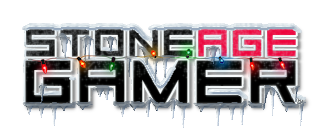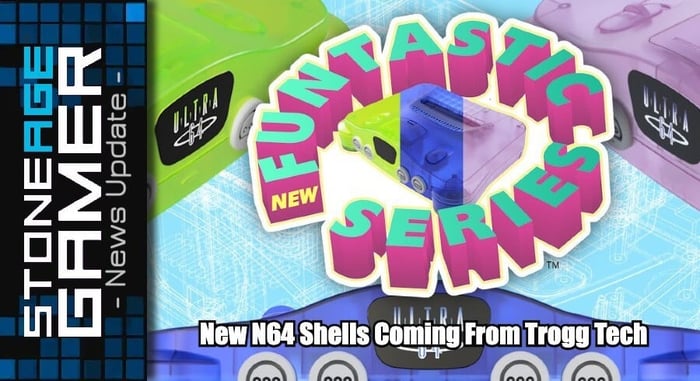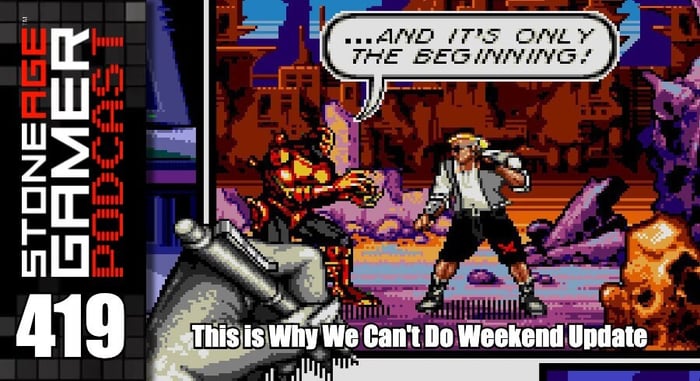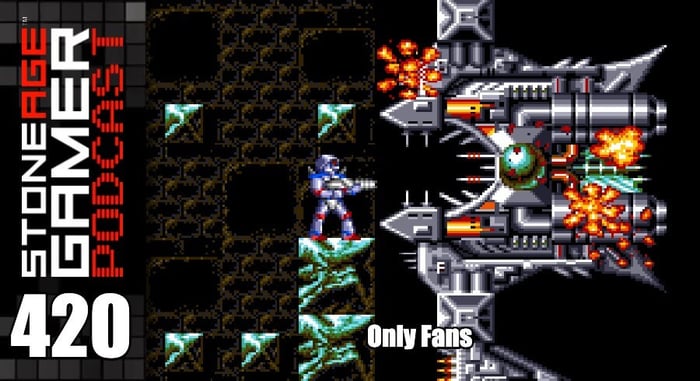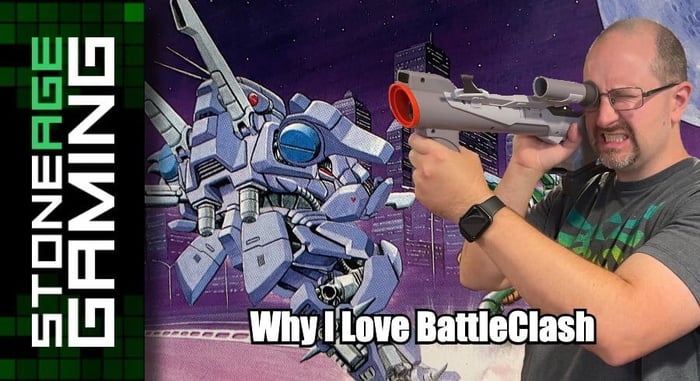
Stone Age gaming: Why I Love BattleClash
Battleclash for Super NES isn't a game that gets a lot of love, but maybe it should. If you like Punch-Out!! and light gun games, BattleClash and its sequel Metal Combat: Falcon's Revenge are fascinating games that may not be perfect, but absolutely deserve to be played more.
Transcript of the video:
Hi everyone. Kris from Stone Age Gamer here. And welcome back to Stone Age Gaming. Today I want to talk a little bit about one of my very favorite game franchises. Punch up now punch out on the surface is a boxing game. You're a little Mac, you're a boxer from the Bronx, and you punch out your opponents in boxing matches and count the ten. And it bites by the basic rules of boxing. But when you actually play the game and you get past characters like Glass Joe or Gabby Jay, you realize that there's a lot more to this game that's puzzle oriented than boxing oriented. It's all about facing these gigantic opponents, and they're big and they're colorful with amazing character designs. And you have to figure out their tells. You have to figure out how to get past their defenses and then capitalize on those secrets. It's really an action puzzle game, and it's one of my very favorite things in all of the history of gaming. Now, I also have always been a really big fan of like on games, like in games starting all the way back to duck hunting, things like House of the Dead in the Arcade. I always loved a really good light gun game. Now on the Super Nintendo, there's a pair of underrated games that capitalizes on both the great aspects of punch out and light gun games, and it combines them both in a brilliant little series called Battle Clash and its sequel, Metal Combat Falcon's Revenge. These games don't get a whole lot of attention, but I absolutely love them. And here's why.
I’ve said before that one of my favorite things in gaming history was the evolution from 8 to 16-bit gaming. Super Mario Bros 3 to Super Mario World. Castlevania 3 to Super Castlevania 4. Mega Man 6 to Mega Man X. It was one of the most amazing looking leaps I could have possibly imagined as a kid. But Another one that often gets overlooked was the evolution from The Zapper to the Super Scope.
Where the NES had you holding a single handed light gun, the SNES put you behind the scope of a freaking bazooka, and that’s not just a figure of speech. A big part of what made the Super Scope so special was the scope itself. It not only allowed for much more precision aiming than the Zapper could offer, but it gave the games that were compatible with it a different feel entirely.
The accessory came bundled with a 6 game compilation called Super Scope 6. There were two Tetris-style puzzle games called Blastris, a sort of whack a mole type of thing called Mole Patrol, and 3 variations of Lazerblaster, a game about shooting missiles. This was a great compilation full of personality and simple addictive games, but it didn’t take long to want more out of my fancy new light gun. The Zapper had all manner of interesting stuff during its lifetime like Gumshoe and Bayou Billy, and now it was time to see what the power of the Super NES could do with light gun gaming.
BattleClash was released in October 1992, and I’ll never forget how I felt when I discovered its existence. First I saw it on this promotional poster in this tiny blurb, and I thought it looked awesome, though it was so small it was hard to tell exactly what I was looking at. Then came the TV commercial.
Seeing it in motion was all I needed. I begged my parents to take me out to get the game and when I made it home, I was blown away. And just like Punch-Out!!, it didn’t take long for me to learn that there was much more going on behind the game’s basic mechanics.
Whenever you press the fire button, your Standing Tank or ST fires a basic shot. These do extremely minimal damage, but can be great for defense. Most enemy attacks can be countered. So if they're firing slow moving yet incredibly damaging missiles, you can flick your Super Scope into Turbo mode and take them all out rapid fire. Or you can just keep plunking away at the fire button and counter their shots manually. This will never be enough to actually defeat an enemy though, which is where power shots come in.
As you play, there’s a meter that constantly fills up at the bottom of the screen. Once it’s full, you can fire off an energy bolt that does an actually noticeable amount of damage. Typically speaking, if you hit your enemy’s torso with one of these shots, it will get briefly stunned, and also be forced to abort whatever attack they’re trying to send your way. There are also special items you can get like bombs which do extra damage, but these full powered shots are your beard and butter throughout the game. Once you learn where your enemies are weak, you can absolutely dominate with a little bit of practice.
This first battle is pretty straightforward. Like Glass Joe, it’s possible to lose, but if you just focus on the basics, there’s very little challenge to taking Garam out. The fun comes in when you learn tha every enemy in the game is made up of multiple pieces.
Take the second battle for example. The Scarab is sort of like King Hippo. Its body is invulnerable except for a small weak spot in his belly. The way the game teaches you to win this battle is to play defense until he opens up his weak spot, blast it with a full powered shot, rinse, repeat. But if you want to have some real fun, focus on one of his legs instead. Just pick one and keep blasting away at it with full powered shots. Eventually the leg will explode and Scarab will crash on its side and no longer be able to move. He can still take a few measly pot shots at you, but you can basically just pummel him until he explodes from there.
The whole game is filled with these kinds of tricks. Artemis can be a bit of a pain to finish off, unless you specifically target her jetpack, which when it explodes takes away about half her health. Every single robot can be taken apart piece by piece, and experimenting in different ways to dismantle your opponents can be the key to not only success, but faster and faster times.
As for the story, it’s kind of cheesy, but in a pretty great 90s kind of way. In the future, people battle in Standing Tanks they call STs. What makes your ST, the Falcon, different, is that instead of a single person inside, yours has two. A pilot and a gunner. This is why the battles move around so much, because the STs are actually being piloted around while you’re battling. The computer is your twin brother as the pilot, and you're naturally the gunner. This is pulled off exceptionally well in game because the camera makes it actually look like you’re following your opponents around. It’s even baked into the gameplay with your opponents making sharp turns and your ST temporarily losing sight of them to catch up. You’re out to stop the big bad Anubis and his battle chiefs because he killed your father. Along the way you’ll run into a crazy cast of characters, each with some super cool looking STs. Most will be foes, but some will eventually turn to your side to help you out at the end of the game. Yes, it’s all a bit cliche, but it works well enough, and whatever cheese is too much in terms of narrative is more than made up for with truly excellent gameplay.
A year later, a sequel was released, though you’d be forgiven for not knowing it was a sequel at all thanks to the name Battle Clash not being anywhere on the box. The Super Scope had been out for a while, and it was time for Nintendo to unleash its second wave of games for it. These included a Mario shooter called Yoshis’ Safari, and Metal Combat: Falcon’s Revenge.
Metal Combat, which was obviously named like that in order to somehow piggyback off the popularity of Mortal Kombat, was an interesting follow up. The same basic premise remained in place, but this time they added a few new features into the mix. There was now a 2-player co-op mode where a second player could use the controller to act as your ST’s pilot. It’s pretty tough, but it’s also really fun. The second major addition was the fact that you energy meter could charge up multiple times. This means that it takes a lot longer to get a fully charged Energy Bolt, but if you manage to successfully wait that long the ensuing blast is devastating. It basically ups the ante of the game’s pre-existing risk reward system.
Overall the whole thing is lacking a bit of the first game’s polish. The difficulty is all over the place, ratcheting up pretty quickly towards the end, while the beginning is overly easy thanks to the new Energy Bolt system. Characters are neat, but not quite as well made as the originals, though the returning STs are a welcome addition. Music is also a bit of a step down. It’s not bad at all, just not quite as good as the original.
These games are so much fun, and so full of character that it’s a terrible shame they haven’t been revisited by Nintendo since the 16-bit era. They even look great when stacked up next to other Nintendo characters, like in this awesome pamphlet they used to give out at Toys r Us stores.
I doubt we’ll see Battle Clash again, but I’ll always be keeping my eyes out for Falcon, Mike, and any other STs that may come my way.
So no, the battle class series never properly took off. Clearly the first one sold well enough to get a sequel greenlit and tossed out there into the world, but with a name metal combat shock as a revenge. Nobody even knew that it was a direct sequel to Battle Clash unless they were really paying attention to the commercials or something. So the series never lived on past that. Nintendo hasn't really done much in the way of light guns since then. I was always really bummed that the battle clash games never hit to win. But either way, as you can see, there's a lot of similarities between the basic core concepts of punch out and battle clash, basically taking what made Punch out special and applying a light gun target shooting game to that concept. It's such a great thing and it's got a weird story. It's pretty cheesy, but who doesn't love a good little bit of cheese every now?
And I would love a modern take on battle clash because these kinds of experiences are so unique, like real shooters, like sin and punishment and Star Fox and Panzer Dragon. And they kind of started to make a little bit of a comeback, you know, and maybe light gun games will find their time in the sun once again. Will it be like I showed you in the video, looking through a scope and actually tracking the characters across the screen? Probably not. But there's so much potential fun to be had in Battle Clash. I would just love to see more of it out there. Thanks for watching, everybody. If you liked what you saw here today, please follow comment like and subscribe and let me know. Are you also a Battle Clash fan? Do you have a super scope and have you ever played Battle Pass before? Are you going to try it now that you've seen this video? Are you a big punch up fan? You think I'm crazy for thinking these two games are similar? Whatever it is, I love battle clash discourse. So please pile on those comments. I want to hear from everybody. Thanks again on behalf of all of us here at Stone Age Gamer, keep playing games.
